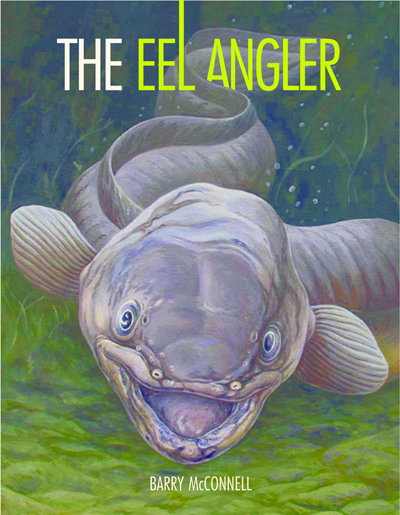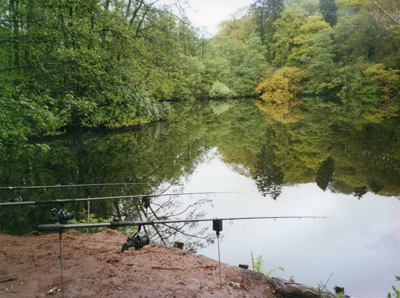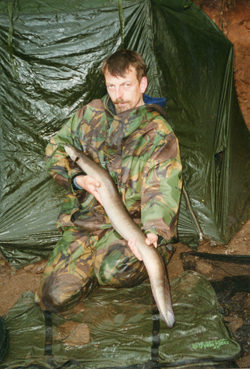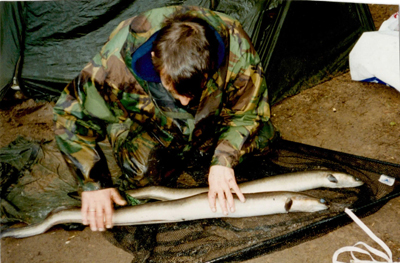Book Extract – The Eel Angler – Barry McConnell
The Eel Angler by Barry McConnell is the true-to-life account of fanatical eeling adventures that takes Barry from Cape Wrath in Scotland to the Lizard peninsular in Cornwall via a winter in Wales, camping on a boat in Shropshire, to summer in February in the Southern Hemisphere. It’s a huge book running to almost 400 pages, liberally illustrated. A hundred years from now your great grandchildren might be asking, ‘What’s an eel?’ Hopefully there will still be copies of this book kicking around, maybe preserved in museums, such is the plight of a once common species that now appears to be drinking in the last chance saloon. Maybe you should be taking inspiration from this tome while you can…
Here’s an extract to tempt you:
THE EEL ANGLER – CONTENTS
1. Born to Fish
2. Bills Pool
3. Start on the trail of a 5lb eel – Grown men going fishing
4. Still on the trail of a 5lb eel – A Learning curve
5. Dawn Eels
6. Spawn-time Eeling
7. Wem 7
8. Jurassic Park
9. Noah’s Ark
10. A Difficult Swim to Fish
11. The Third Week in June
12. Nothing Ventured: Nothing Gained in New Zealand
13. Try Something Different
14. Eutrophic Waters
15. Exploring local waters
16. Escapades and Mishaps on Canals
17. Three Seasons on the Claypit
18. An Encounter with Age
19. Daytime Mission
21. Highland Eeling
22. Summer in February in New
23. The Deeper the Water: The Bigger the Eel in Australia
24. Wilderness fishing for Ferox and Eels
25. The Deepest Swim in England
26. Winter eel-fishing
27. Australia 2010 Eel Record Attempt
28. Gravel Pit Experiences
29. A Repeat Capture
30. Endword
Foreword – by John Davies (NAC Chairman) March 2012
It’s often said nowadays that there’s no characters to be found in angling anymore, which is hardly surprising in this day and age of political correctness where anything but conformity is viewed with cynicism, and that to dare to be different will get you labelled as eccentric. I suppose we can therefore establish that anyone who devotes their life and soul in fishing for that enigmatic of all fish, the eel, must possess a particular kind of personality, and they don’t come anymore as unique as Barry McConnell.
From his early childhood beginnings on the local canal, he progressed to carp fishing in the early ‘seventies, ultimately specialising in the pursuit of eels and zander, of which he has a list of massive fish second to none. He also has a love of the great outdoors that has no boundaries, and since those early days fishing for tiddlers, it’s seen him fish far and wide around the country in his search for that elusive monster eel.
Along the way, Barry has accumulated a lifetime of knowledge that reflects in the dedication to his craft; he also has that uncanny knack of catching big eels from a diversity of venues. Apart from his experience as a worm farmer for the angling trade and his exhaustive articles written about his fishing exploits for the National Anguilla Clubs fishing magazine, Barry is known to all in the NAC as ‘Only the Lonely’ for his ability to fish in the wilderness on his lonesome. He is also very well known for his exploits into the manufacture of fishing tackle; the ‘Rollover’ is the exceptional bite indicator for the serious eel angler. Mix all this professional expertise with free thinking, Gordon Ramsey etiquette, and a magnificent sense of humour, and you have Barry.
In this book you will find an honest, warts-and-all journey of a dedicated eel angler, a man who takes his fishing to extreme limits whether it’s in the United Kingdom, or Australia and New Zealand. The campaigns that have lead Barry and his compatriot Pete Drabble in a quest for the mysterious eel are without doubt adventures that will inspire others to pursue their own dream.
CHAPTER 5. DAWN EELS
June 1996: The first time I set eyes on this picturesque Shropshire mere it took my breath away. If I had to paint a picture of my dreams, my dreams of the perfect big-eel water, it would have looked just like this.
Over thirty acres of water is sheltered by old, mixed woodland that has been throttled by rhododendrons. Many larger trees tower majestically above the impenetrable entanglement, and some of the older trees have died to become great towering skeletons, silhouetted against the sky line. Silently decaying figures draped with lichens, reflecting from the mirror calm surface of the mere. Several dead branches from a sunken tree poke through the surface and cast shadows on the reflection where they rise out of the water. Everything looks old, neglected and mysterious. Mystery is something that always excites me and here it became a kind of nervous feeling in my gut as I looked out over the water in a way that only anglers do.
On our first fishing trip to the mere, Pete (The Anguilla Guerrilla) and I cast in with an hour to spare before dark. We didn’t know if this mere held any eels – it just looked like it should. In fact we didn’t know much at all, and the purpose of this trip was to explore the water and try different areas with our multi-rod set up. We had three rods each, and after whacking one bait to the far side, I dropped another in the nearside margins, then walked along the bank, and, with an underarm lob, placed the third bait beneath an overhanging tree.
The surrounding woodland became motionless as I settled down after casting my last rod. The wind had suddenly dropped, and now that the noise of swaying trees had gone, you could hear melodic bird-song coming from the treetops. I sat on the bed-chair in the bivvy and listened to the loud Springtime bird chorus. The bird-song had a definite effect in ironing out a few wrinkles. I felt closer to nature as the calming sounds washed over me and soothed away my anxiety and stress. I sat back and allowed the sound to cleanse me. The light faded into the evening sky, and,, one by one the birds stopped singing as the woodland gradually fell silent; it was so still it seemed eerie. Not a breath of wind stirred the undergrowth and there were no traffic noises to disturb the peace. It was so still you could have heard a pin drop.
The buzz of mosquitoes rose out of the silence as they gathered in a swarm over the water. The noise got progressively louder and changed tone to a loud high-pitched hum, before gradually fading away as the swarm dispersed into the darkness to find a meal. They were hungry, too, judging by the sharp, painful bites I was getting. It was time to cover exposed skin and settle down for eeling-hour, the first hour of darkness, when we could expect to get a run.
Beneath the canopy of trees, the combined rustle of beetles, mice and other small creatures of the night became noticeably loud. The shadows from the undergrowth where surrounded by an aura that seemed to be whispering. My awareness intensified until heightened senses had me on the alert, and I found myself poised over the bite alarms. I had an uncanny feeling that something was about to happen.
Aagh-ee-ee-eek! A loud, blood-curdling scream came rolling across the water, giving me gooseflesh. What was that? Was it a death cry? More screams came out of the dark. Then I recognised the characteristic screams and realised that I was listening to the night-time frolics of young badgers mock-fighting outside their sett.
During the night there was a flurry of spawning activity amongst the roots of an alder tree, further along the bank, past Pete’s swim. I heard Pete recast each of his three rods in the direction of the tree before settling down.
I stayed awake all night, alert and expectant, but never got any runs. The only activity came from the occasional twitch bite when small nuisance fish nibbled at my massive bait – a big ‘Medusa’s head’, a bunch of six or seven lobworms on a size four Sidley Baitholder hook. Several mosquitoes had entered the bivvy. They needed to be removed or they’d bother me all night. There was no need to zip up the door and squash, spray or smoke them out. The best way to clear a bivvy of mosquitoes is to turn off all torches and light sources, open the door so that they can see the way out, and then frantically bang the roof and walls inside the bivvy in a full-scale mozzy attack. I kept this up for 10 to 20 seconds or so. All the mosquitoes evacuated the dark inner bivvy and made their escape into the night air. It worked every time.
As it started to get light, mosquitoes swarmed over the water once again, then moved into the woods, zigzagging in a frenzy beneath the trees as their buzzing got much louder, rising in pitch. Wow! I’d never heard it as loud as this before. The crescendo reached a peak, then suddenly ceased as the mosquitoes took to the shade and retired for the day. There was a dark scummy patch floating like a giant oil slick on the surface of the mere. Closer observation revealed thousands of empty mosquito cases left from the night-time hatch, which had mixed to a frothing patch of bubbles from the shoals of night-feeding bream. Tench had started their early-morning feeding spree in the margins; many patches of tiny bubbles fizzed on to the surface, then drifted on to combine with the floating slick.
I went to the swim next door. “Did you hear those mozzies? Jeeesus!”
Pete was awake and expecting me. He suggested some sustenance, and, as he prepared the ritual brew and bacon butty, he told me about the lack of action, with not even a twitch bite during the night, and wondered if there were any eels in the mere. Perhaps we were wasting our time.
Suddenly the unexpected happened: Pete’s high-tech bite alarm – a two pence piece placed on the open spool – clanged on the tin lid he had carefully positioned beneath his reel. Coils of line were ripping from the spool, faster and faster, until a loud whirring sound was created by the line slapping against the rod as it coned down to rustle through the tin-foil cylinder jammed in the butt-ring.
Pete ran to his rod, closed the bail arm, struck, and met with a solid, thumping resistance. The rod arched round to its maximum test curve of three pounds, then, he had to give line as a powerful fish moved in the deeps.
“Bloody hell, I’m in to something massive. Must be a carp.”
Jag, jag – something about the motion of his rod reminded me of pike.
“Perhaps it’s a pike?”
“Must be a thirty, I can’t shift it.”
He gave more line as the fish made another powerful run.
“Look at that, it’s going wherever it wants. It’s one of those unstoppables. Like, like – a big eel!”
“I doubt it Pete. There’s probably none in here anyway.”
“What else – a catfish?”
The rod bucked and flexed in response to the fighting fish, while the line was making a worrying, rasping sort of noise as though it was about to fray as it see-sawed over the hardened SIC rod-rings which seemed to absorb the noise and amplify it through their brittle material.
“Ten-pound tench? No, no, it’s too big for a tench – thirty plus.”
Pete still wasn’t sure what he was attached to. Gradually he managed to pump the fish closer and retrieve line, until the fish was on the surface just a couple of rod-lengths away. I stared hard at the commotion on the surface to try and identify the fish but I couldn’t distinguish between the confusion of fish, ripples and shadows in the semi-darkness. The fish dived for the bottom, once, twice and then it was on the surface again – now only ten feet away.
“F***ing hell! Pete, it’s an eel! A personal best, it’s massive.”
I missed it on the first attempt with the landing net because the last couple of inches of its tail hadn’t quite been drawn over the rim of the net. With any other species of fish it is only necessary to get the first half of its body over the rim, then raise the net and the fish will fall into the bottom, head first. Not with eels though. So, instead of falling into the net when I raised it, the eel wriggled backwards and disappeared beneath the mesh.
Luckily it didn’t make its escape completely, and Pete was able to draw it towards the landing net once again.
“Pull – heave! More! More! Get its head right up to the top of the net, over the spreader block – then its tail will be past the rim of the net.”
Even though the net was very large at fifty inches, it was difficult to get the whole length of the struggling eel within its frame. This was a tense moment, and anxiety was showing as I raised my voice.
“Pull harder! Now, now, further! Come on Pete, what’s up with you?”
The eel had back-paddled until it was under the net once again.
“You bloody well try it. Look at my rod bending – it hasn’t got the power. I’m giving it everything.”
“Sorry, sorry…….”
I repositioned the net and Pete wound down on to the eel until his rod -ip was almost touching the water. Everything went right this time as he was able to put the rod through a wider sweep. The rod strained to the limit of its power curve; it was high up above his head, almost as far back as he could pull it, just as the eel’s head reach the spreader block. I lifted the net and the eel was in. We’d done it. I noticed Pete was shaking as we pulled back the folds of netting. The eel was big, bigger than any eel we’d seen before. The biggest eel I had ever seen was 3lbs 10ozs and this eel dwarfed it. As we admired the specimen lying in the net, Pete’s other rod was away.
Clunk! A two pence piece fell off one of his other reels. Another run! As Pete thumped the hook home, I rushed to transfer the eel to the keep-net and took the landing-net to his assistance. He was in to another good eel, and the rod hooped round as he put the pressure on, gradually easing it out of the deeps, towards the waiting net. He managed to get the eel up in the water and drag it slowly along the surface. Its tail snaked up into the air, then came down on the water with a loud slap as he kept the pressure on and brought the eel in a straight line towards the net. He kept it coming straight, slowly coaxing it over and into the net. I hoisted the net on to the bank and opened it out on to the unhooking mat. There lay yet another big mature eel, even bigger than any we had seen before today. We dampened the weigh-sling and zeroed the scales. I lifted the eel and held my breath as the dial went round; 2, 3, 4, 5. . .
“5lbs 4ozs. Well done Guerrilla. A personal best by a mile and by far the biggest eel I’ve ever seen.”
We measured it – forty-one inches long with a nine inch girth.
“Are you thinking what I’m thinking?” Pete was staring at me, wide-eyed, with an odd, knowing sort of smirk on his face.
“What?” I asked.
“The first one was bigger!” he said.
We took the other eel out of the keep-net. I will never forget the moment we laid that eel on the unhooking-mat. There lay the biggest eel I had ever seen. It was an incredible, old-looking creature, very thick around the paunch with a very long body the bronzed colour of a fully mature eel. Its head tapered towards its mouth in perfect proportion to the rest of its body. It looked like it was blind where cataracts had skinned over its eyes; they were an odd, cloudy, slate-blue colour, bulging and looked to be filled with fluid. There was no eyeball in either of the sightless eyes.
“Glasshoppah” said Pete, in a funny oriental accent.
“It’s definitely bigger than the other.” I offered. “Much bigger. Bloody hell! It looks like a seven. This is unreal.”
We weighed it in at 6lbs 12ozs and took some photos and measurements – length, forty-three inches and a girth of ten inches. Pete had beaten his personal best twice in ten minutes.
“Is this really happening?” was all Pete managed to mutter.
* * * * * * * * * *
The Eel Angler runs 384 pages, each 245mm by 190mm and is lavishly illustrated throughout in full colour.
The cloth-bound edition of is limited to 1500 copies, with a dust jacket priced at £35.00 plus £7 post and packaging.
A further 50 leather-bound copies have been produced with with alternatives of gold, silver or blind embossing to front and spine. Special endpapers, silk ribbon marker, coloured ‘top and tails’, special book-plate, to be numbered and signed by Barry in a lined slipcase priced at £200 plus £10 post and packaging.
You will find options to pay via PayPal or cheque on the Zandavan web site.
For more products, articles, videos and much more, why not visit Barry’s Zandavan web site.





Hi barry cannae wait to see ya back on the gullies in adswood pal